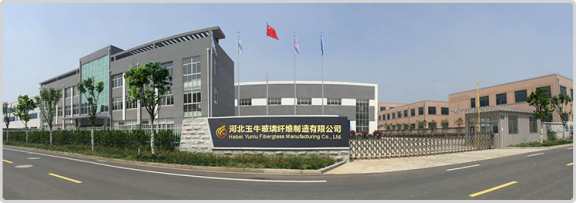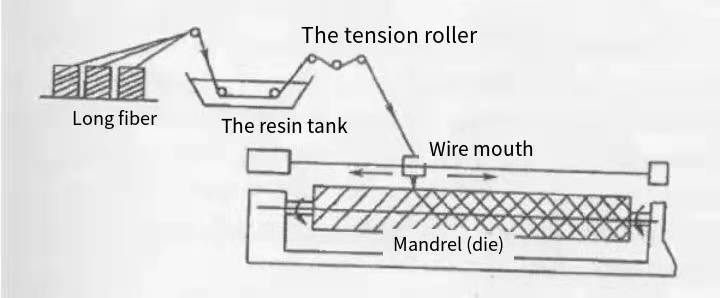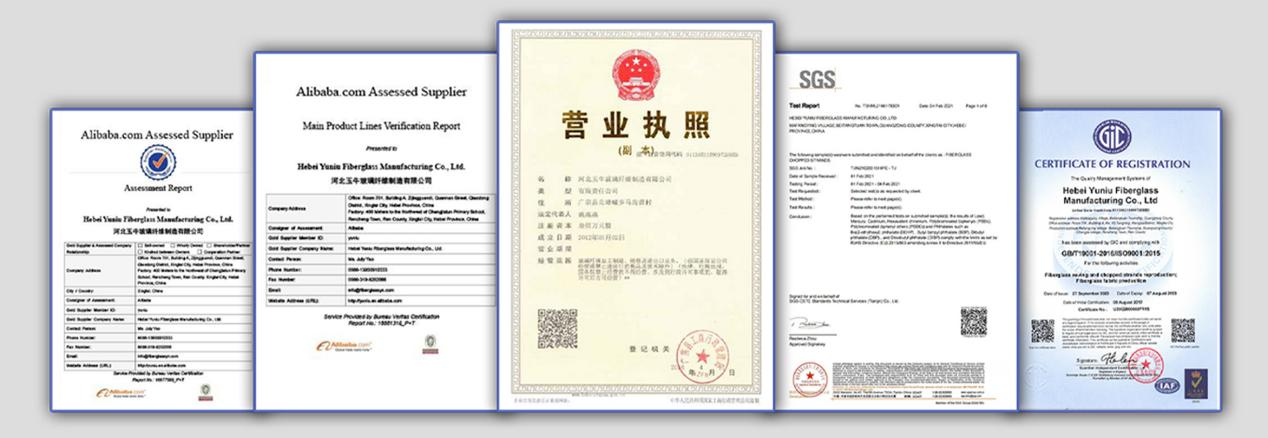Fiber winding is one of the manufacturing processes of resin matrix composites. There are three main forms of winding: toroidal winding, plane winding and spiral winding. The three methods have their own characteristics, and the wet winding method is the most widely used because of its relatively simple equipment requirements and low manufacturing cost.
Under the condition of controlling tension and predetermined line shape, the continuous fiber or cloth impregnated with resin glue is wound continuously, evenly and regularly on the core mold or lining by using special winding equipment, and then solidified under a certain temperature environment to become a composite material molding method of certain shape products. Processing diagram of fiber winding molding process:
There are three main forms of winding (FIG. 1-2): toroidal winding, planar winding and spiral winding. Ring to the reinforced materials of mold and core axis at close to 90 degrees (usually 85-89) in the direction of the continuous winding on the mandrel, reinforced materials with the core of the matrix on both ends of the pole hole tangent and continuous winding in the direction of the plane on the mandrel, spiral wound reinforced material and with tangent on both ends of the mandrel, but on a spiral mandrel continuous winding on the mandrel.
The development of fiber winding technology is closely related to the development of reinforcement materials, resin systems and technological inventions. Although in the Han Dynasty, the process of making weapon rods such as Gorilli and halberd could be made by impregnating lacquer with long wooden poles plus longitudinal bamboo and circular silk, the technique of fiber winding didn’t become a composite material manufacturing technology until the 1950s. In 1945, the first spring-free wheel suspension device was successfully manufactured by fiber winding technology, and in 1947, the first fiber winding machine was invented. With the development of high performance fibers such as carbon fiber and aramong fiber and the appearance of microcomputer controlled winding machine, fiber winding process, as a highly mechanized composite material manufacturing technology, has been rapidly developed, and has been applied in almost all possible fields since the 1960s.

About US: hebei Yuniu Fiberglass Manufacturing Co., LTD. We mainly produce and sell e-type fiberglass products, such as fiberglass roving, fiberglass chopped silk, fiberglass chopped felt, fiberglass gingham, needled felt, fiberglass fabric and so on.If any needs, please contact us freely.
According to the different chemical and physical state of resin substrate during wrapping, wrapping techniques can be divided into dry, wet and semi-dry methods:
1. Dry
Dry winding adopts pre-impregnated tape at stage B after pre-impregnated. Preimpregnated strips are manufactured and supplied in special plants or workshops. For dry winding, the pre-soaked yarn belt should be heated and softened on the winding machine before being wound to the core mould. The quality of prepreg yarn can be controlled accurately because the content of glue, size and quality of tape can be detected and screened before winding. The production efficiency of dry winding is higher, the winding speed can reach 100-200m/ min, and the working environment is cleaner. However, dry winding equipment is more complex and expensive, and the interlaminar shear strength of winding products is lower.
2. Wet
The wet winding method is to wind the fiber on the core die directly under the tension control after the bundle and dip glue, and then solidify. The wet winding equipment is relatively simple, but because the yarn belt is wound immediately after dipping, it is difficult to control and inspect the glue content of the product during the winding process. Meanwhile, defects such as bubbles and pores are easily formed in the product when the solvent in the glue solution is solidified, and the tension is also difficult to control during the winding. At the same time, the workers operate in the solvent volatile atmosphere and the environment of flying fiber short hair, the working conditions are poor.
3. Semi-dry method
Compared with the wet process, the semi-dry process adds a drying equipment on the way from fiber dipping to winding to the core mold, and basically drives away the solvent in the glue solution of the yarn tape. In contrast to the dry process, the semi-dry process does not rely on a complex set of preimpregnation equipment. Although the glue content of the product is not easy to accurately control in the process as wet method and more than a set of intermediate drying equipment than wet method, the labor intensity of workers is greater, but the bubble, porosity and other defects in the product is greatly reduced.
The three methods have their own characteristics, and the wet winding method is the most widely used because of its relatively simple equipment requirements and low manufacturing cost. The advantages and disadvantages of the three winding methods are compared in Table 1-1.
Table 1-1 The ratio of ten thousand methods of three winding processes
|
Compare the project process |
Dry winding |
Wet winding |
Semi-dry winding |
|
The cleaning condition of the winding site |
The best |
The worst |
Same as dry method |
|
Reinforced material specification |
Not all specifications Can be used |
Any specifications |
Any specifications |
|
There can be problems with carbon fiber |
There is no |
Floss may lead Cause of failure |
There is no |
|
Resin content control |
The best |
The most difficult |
Not the best, a little different |
|
Material storage conditions |
Must be refrigerated and stored in records |
There is no storage problem |
Similar to the method, the storage life is short |
|
Fiber damage |
More likely |
Chance at least |
Less chance |
|
Product quality assurance |
Have an advantage in some ways |
Strict quality control procedures are required |
Similar to dry method |
|
The manufacturing cost |
The highest |
The minimum |
Slightly better than the wet method |
|
Room temperature curing |
Can’t be |
may |
may |
|
Application field |
Aerospace/Aerospace |
Widely used in the |
Similar to dry |
Post time: Dec-20-2021


